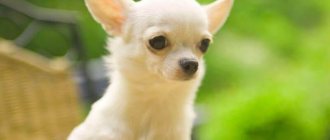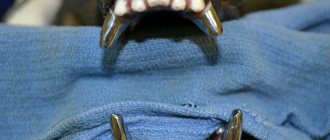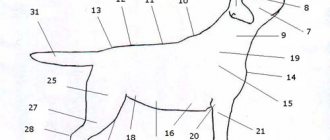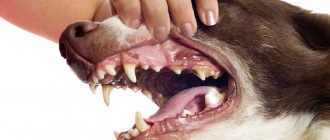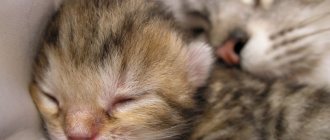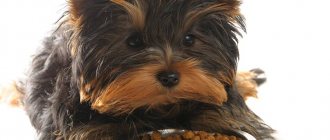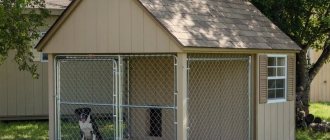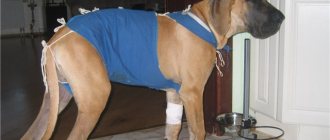Yorkshire Terrier Dental Care
The Yorkshire Terrier is one of the breeds of decorative dogs that require maximum attention and special care.
The Yorkshire Terrier's most vulnerable spot is its teeth. The change of teeth in Yorkies is the main indicator of the health of the body as a whole, since its digestive tract depends on this process.
At birth, Yorkies are toothless. In the middle of the first month of life, the baby terrier begins to develop milk teeth.
How many baby teeth does a Yorkie have at the beginning of its life? A two-month-old Yorkie has 28 of them. At 3-4 months, small Yorkies begin to change their teeth, which is associated with the process of growing up.
After changing teeth, it is recommended to accustom the baby to the daily procedure of brushing them in order to remove plaque and avoid the appearance of tartar.
To do this, you should purchase a special toothpaste from a veterinary pharmacy. It would be even better to have your pet’s teeth cleaned several times a month by specialists in a veterinary clinic or special salons.
Chewing bones, which can be purchased at any veterinary store, are very helpful in cleaning Yorkie teeth.
Visit to the veterinarian
The sooner your Yorkie starts visiting a canine orthodontist, the faster he will get used to dental procedures. The doctor will remove baby canines and incisors, install a device to straighten the teeth, correct the bite, and give recommendations for cleaning the pet’s mouth.
The dog is shown to the doctor even before the temporary teeth are replaced. The specialist will assess the condition of the animal’s jaw and give a forecast about the Yorkie’s future bite.
An adult is taken to the clinic 2 times a year to have tartar cleaned. Deposits are removed using a laser; the operation is painless.
Yorkshire Terrier at a doctor's appointment
Possible problems
During the period of teeth change, puppies usually experience a sharp decline in mood, the reason for this is severe itching and pain in the gums.
At these moments, the baby should be given maximum attention, as he feels extremely helpless and vulnerable. Here, proper diet and compliance with the veterinarian’s recommendations received during this period are of great importance.
Not everyone knows how many teeth there are in the mouth of their beloved pet. A Yorkshire Terrier puppy's mouth contains 28 baby teeth, which appear two weeks after birth and begin to gradually fall out at the age of four months.
Then the molars begin to grow: first, the incisors change, and then the fangs change. There is a misconception that baby teeth do not have roots.
There are roots, otherwise how would they stay on the jaw? During the growth of permanent teeth, milk teeth begin to dissolve, their fixation weakens, and therefore, over time, they fall out.
The process of loss of a puppy’s baby teeth (especially the incisors) goes almost unnoticed. The teeth are so small that it is quite difficult to notice them.
Most of the teeth that fall out are swallowed by babies while eating, and this is normal; there is no reason to worry in this situation.
We suggest you read: How horses sleep: standing or lying down
Changing teeth is a natural process that will have to be faced one way or another.
When changing incisors, there are usually no special problems, but the canines are worth paying attention to. If your Yorkshire Terrier's teeth have not fallen out before the age of eight months, it is imperative that you consult a veterinarian and have them removed.
These measures are necessary in order not to disrupt the correct bite of the pet. All dog shows have specific requirements for bite form.
A scissor bite is considered normal (the upper canines cover the lower ones, but do not touch each other). Before this age, the Yorkshire Terrier must undergo a complete change of teeth, and their number should be 42 (incisors, canines, premolars and molars).
During the period of changing teeth, sometimes an unpleasant odor can be heard from the dog’s mouth. It is formed due to food particles that get stuck between teeth located in one place.
In this case, there is no need to worry, just look into the puppy’s mouth and look at the condition of the teeth.
Yorkie's overbite
The correct bite is important for all dogs.
The Yorkie's correct bite is a scissor bite. The upper canines partially cover the lower ones, their surfaces do not touch. The lower canines are located in the gap between the canine and the incisor.
How to determine the correct bite in puppies
In newborn dogs, it is almost impossible to determine the correct bite, but already in a one-month-old puppy, the bite is formed correctly. Close attention should be paid to the lower canines.
If the fang is in close contact with the incisor, there is a possibility of an overbite in the future; if it rests on the upper gum, there is an underbite.
Some puppies may have a “baby underbite” that will correct itself over time. However, if the distance between the lower and upper incisors is too wide (more than 3 mm), this indicates that the underbite will remain into adulthood.
What are malocclusions?
Snacking is a fairly common disorder, which is even considered normal in some breeds (for example, bulldogs). The lower incisors protrude in front of the upper ones.
Underbite is diagnosed when the upper and lower incisors do not meet, leaving a wide gap between them.
Direct bite - canines and molars do not partially meet.
Open bite - incorrectly grown incisors do not close together.
Crooked bite is a complex genetic pathology.
Disorders also include an excessively narrow lower jaw.
Attention! The bite may look normal, but the lower canines constantly injure the palate and gums, so it is recommended to remove them.
Ways to correct a bite
An incorrect bite deprives a dog of breeding value, and in some cases can cause diseases of the digestive tract (due to insufficient chewing of food), inflammation of the gums, and a fistula in the palate due to tissue injury from an incorrectly grown tooth.
The decision on whether to correct the bite or not is best made together with a veterinarian-ontodontist, who will help determine how dangerous the disorder is for the health of the Yorkie.
The best time for correction is from 6 months to a year. The veterinarian installs braces. They are removable, which need to be replaced with new ones from time to time, and non-removable metal ones, which need to be tightened as the dog grows.
Growing up stage
Adulthood begins at 4-5 months of the animal's life. The puppy becomes irritable, his gums hurt and itch. Sometimes she cannot control her bowel movements, and her immunity decreases.
This is a crisis period in the life of a Yorkshire Terrier. You should treat him with understanding and kindness.
During this period, it is useful to feed a teenage dog with calcined milk, cottage cheese, mineral supplements, and calcium glycerophosphate.
All these symptoms signal the beginning of maturation in the puppy’s body.
Preventive health procedures
To maintain oral health, dogs need to have tartar removed. This is done using special pastes or in the veterinarian's office. Plaque on enamel can lead to inflammation of the gums and loss of incisors. Once every 2 weeks, small dogs need to put anti-gum gel into the oral cavity.
Important! Young dogs are not allowed to play tug games. Forceful loading on the jaw can deform it.
During the active change of the dentition, the dog should not be allowed to gnaw on very hard bones, metal objects and stones. They can deform soft, unformed gums.
It is necessary to periodically inspect the mouth of a young Yorkie. An even dentition and a standard number of teeth will help not only win prizes at exhibitions, but also maintain the health of the animal. Cleaning and removing stones will save your small pet’s chewing apparatus. You shouldn’t lead to possible problems.
Yorkshire Terrier Dental Care
When you come to the dentist with your Yorkshire Terrier, ask what methods of pain relief the clinic uses. Most likely, he uses local anesthesia with an injection into the gum and general anesthesia. For a Yorkie, the first is preferable, but it is even better if you can avoid pain and remove the interfering baby tooth with a simple manipulation.
Yorkies usually tolerate a trip to the dentist well, trustingly allowing their mouths to be examined. Even the removal of tartar will be tolerated by these small animals; in modern conditions it is done using ultrasound and is almost painless. The effect of anesthesia is not always justified and can cause shock in the dog.
If you are very afraid to go to the veterinary hospital, try to loosen the interfering teeth, but when the animal refuses to eat, it is better to visit a doctor. Moreover, if you are going to take part in exhibitions, then it is necessary to take care of even, white teeth!
We suggest you read: How to properly feed your dog natural food?
Observe whether the Yorkshire Terrier's bite is correct; if it is scissor-shaped and the upper canines slightly overlap the lower ones, then everything is fine.
Your Yorkie's teeth are beginning to change. Often the owners of these cute dogs ask how long this process lasts.
If the puppy does not have problems associated with changing teeth, the process is completed in the sixth or seventh month.
Why are systematic visits to the veterinarian necessary?
Yorkie owners should always remember that this breed has a high risk of developing dental problems, which increases with age. No matter how attentive the owner is, most likely he will not have enough knowledge and experience to detect the disease at the very beginning, while it is still treatable.
A very common disease in this breed is periodontal disease. This is a destructive process that affects the teeth, gums and even the jawbone, and can ultimately lead to the removal of all of your Yorkie's teeth. Therefore, it is especially important to diagnose it at the earliest stages.
Seeing an elderly pet, many strangers wonder why the Yorkie had all its teeth removed. No one actually does this. Simply due to improper care, the teeth decayed and fell out. To prevent this, it is important to monitor your dog's jaw from the moment of birth.
Types of malocclusion
- Misaligned bite. It is formed when one half of the jaw grows faster than the other. Can be corrected by removing the crown.
- Snack. If the upper jaw is shorter than the lower jaw. In this case, the crown is removed and the pulp is closed.
- Underbite. If the lower jaw is shorter than the upper jaw. The adjustment is made using the same method as in the case of a snack.
- Posterior crossbite. When the upper 4th premolar is located on the inside of the lower 1st molar. As a rule, there is no need for treatment because the teeth function normally in this position.
- Anterior crossbite. If the upper incisors are located behind the lower ones. This position of the teeth can be corrected using orthodontic appliances.
Should missing teeth be removed?
It happens that teeth do not fall out in a timely manner. In this case, you need to visit a veterinarian. He will conduct an examination and, if necessary, remove the “overdue” tooth. The operation is performed using local or general anesthesia. It is worth entrusting the choice of the type of anesthesia to the doctor, since he can better see how long the roots of the tooth that needs to be pulled out are, and, therefore, will be able to choose the appropriate method of pain relief. Each method has its pros and cons.
- For example, local anesthesia does not have a negative impact on the dog’s health, it is easily tolerated, and there is no “aftercare” after it. But when using it, the dog may feel pain during the operation.
- General anesthesia completely relieves your Yorkie of pain, but it can cause an allergic reaction or lead to other unpleasant consequences.
If the dog is completely healthy and has no contraindications, the use of general anesthesia is recommended, as this is more comfortable for both the patient and the doctor. It is much easier to carry out a high-quality removal when the puppy does not twitch or break out.
Changing baby teeth
After four months, the baby Yorkie begins to lose its baby teeth. The incisors change first, then the canines. Incisors usually fall out unnoticed. Changing canines is a more complex process.
Requires utmost attention. The owner should be aware of how many molars an eight-month-old Yorkie should have.
If the fangs have not fallen out by the end of the 7th month, you should immediately contact a veterinarian.
Permanent teeth grow through a canal formed in place of fallen milk teeth.
How often to brush your Yorkie's teeth
Yorkie's baby teeth are brushed 3 times a week, and permanent teeth every day. To clean, use dog toothpaste and a short-bristled brush. You can use a light solution of baking soda.
Note! To self-clean the enamel, pets are allowed to chew on young carrots, dried offal, and pumpkin.
Cleaning a small dog's incisors
Difficulties
Incorrect replacement of the Yorkie's teeth leads to uneven row growth. This pathology can be a consequence of both an incorrect diet and the dog’s genetic predisposition.
Reasons also include improper jaw formation and poorly developed chewing apparatus of the puppy.
We invite you to read: The most beautiful horse in the world
There is a case when the root of a baby tooth in an animal does not disappear before the molar begins to grow.
Then a phenomenon is observed in which the molars line up in a row with the milk teeth. The phenomenon is not safe and leads to serious injuries to the dog’s gums, jaw and tongue.
Therefore, in case of such a deviation, you should immediately contact a veterinarian, who, with the help of surgical intervention, will resolve the issue of what is done under local or general anesthesia.
The doctor chooses the type of anesthesia based on the dog’s health condition, also taking into account the length of the root of the tooth being removed.
Care
Get your puppy used to brushing his teeth from a young age. Train him to show his fangs and not be afraid, but do not put your fingers in the gums until the baby fangs appear.
- Buy a brush for small dogs (or a brush for small children) and a special paste at the pet store.
- Apply a small amount of paste to the brush.
- Calmly and gently begin brushing a couple of teeth. If you have trained your Yorkie well, he will not resist the procedure.
- To make cleaning enjoyable and beneficial for your pet, treat him with a small treat at the end of the procedure.
Important: do not use pastes on people. York could accidentally ingest it and become poisoned.
Delayed teeth change
https://www.youtube.com/watch?v=C_TC8VDs024
Yorkshire terrier puppies sometimes experience retention - a pathology when, after the baby tooth falls out, the permanent tooth does not grow at all.
This occurs due to the absence of a molar tooth germ, or its incorrect location.
Incorrect removal of previous primary teeth can also cause abnormal growth of permanent teeth.
How many teeth should a healthy adult Yorkie have?
- Upper jaw:
- incisors (six);
- fangs (two);
- premolars (eight), of which two are small and two are large on both sides;
- molars (two).
- incisors (six);
- fangs (two);
- premolars (eight), of which two are small and two are large on both sides;
- molars (three).
Lower jaw:
And there are 42 permanent teeth.
Features of the structure of the Yorkie's jaw
By the end of the development of the skull, the Yorkie should have 42 teeth: 20 in the upper jaw, 22 in the lower. Yorkie teeth classification:
- incisors;
- fangs;
- premolars;
- molars.
If a dog is missing at least 1 tooth, you can forget about a show career. A professional judge cannot give preference to a dog with an incomplete set.
